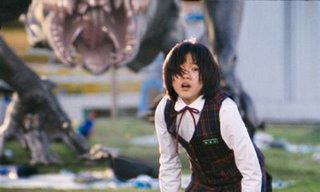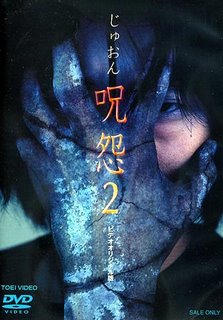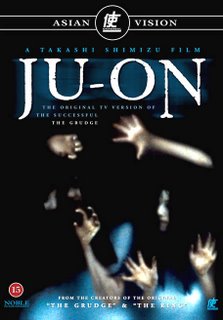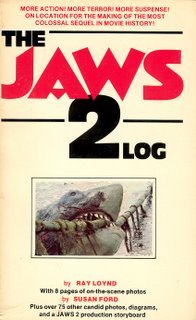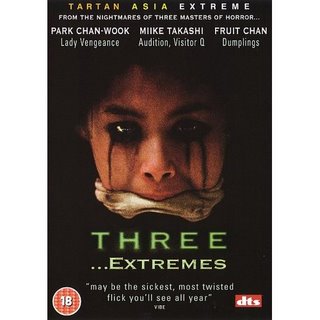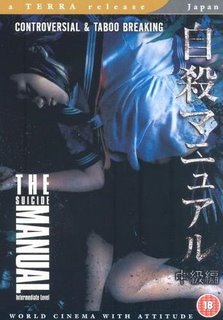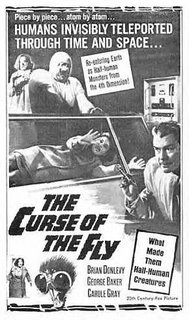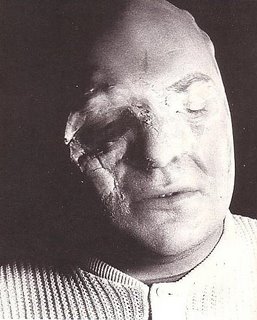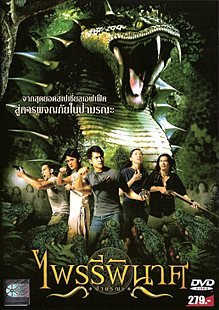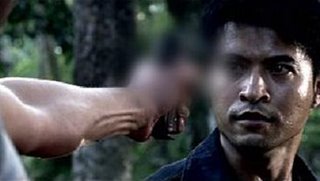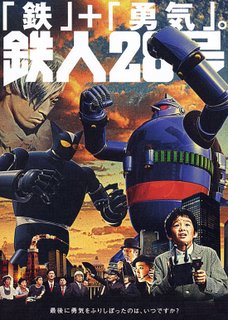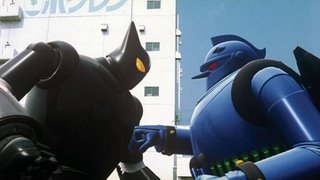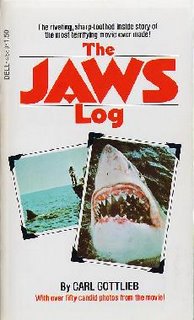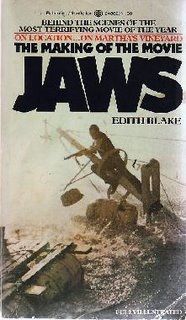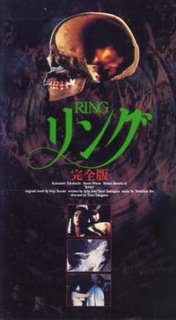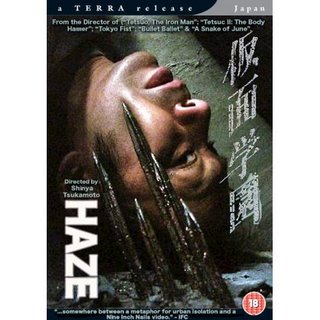August 30, 2006
LADY VAMPIRE (1959) Confused Japanese vampire
LADY VAMPIRE (1959, Japan, Onna-Kyuketsuki)
The lady is a vamp!
Who told us that Japanese movies were sexier and gorier than Hammer films? Here's a Japanese horror from the year after Hammer's classic Horror of Dracula that's neither.
It's more like a tame lesson in what was naughty in the fifties in Japan. Artists models wearing baggy swimwear. Young ladies naked backs. Whipping. OK that's naughty for the fifties, now it's commonplace.
It's in black and white, and dramatically framed in Tohoscope 2.35. There’s a few actresses with heaving busoms, a confused mythos, and not much action. It's more of a dry run for Dark Shadows rather than a homage to Hammer.
It's also an early example of a vampire in a modern-day setting - instead of getting Van Helsing, they set the police on him, but the result isn't a patch on the 'police v vampire' action that you get in The Night Stalker movie or House of Dark Shadows (both from director Dan Curtis).
I've learnt that in Japan, bad guys wear shades and bad women wear big earrings and too much make-up. Our vampire villain (not the title character) turns into a vampire when the moon is full (surely some mistake) and bites to kill rather than to drink. He has a mute dwarf sidekick, an old ghostly witch sidekick, and a bald muscleman sidekick. None of them eat flies and they're all pretty useless at their jobs.
He’s gots a whip, and a fencing foil, pre-dating the swordsman/vampire of Hammer's Captain Kronos, Vampire Hunter, but here the fight scenes are more 'school play' than excitement.
The gently Freudian torture scene where Drac prods a lady victim with a candelabra stand, can only prove that L.S.D. must have reached Japan in the late fifties. Aptly, this film was made the same year as Ed Wood's Night of the Ghouls, about the most positive comparison I can make.
The director (Nobuo Nakagawa) did a much better with The Ghost of Yotsuya the same year, but here appears to have run out of money. The final fight scene takes place only in a wide master shot, with much of the struggle happening off-screen!
If you really must see this, it is at least available in 2.35 widescreen with english subtitles, from Satsuma, for instance.
THE HOST (2006) film of the year, from Korea
THE HOST (South Korea, aka Gwoemul)
The Host with the most (box-office takings in Korea)
From the very first Host posters, I’ve been wanting to see this. Thankfully on Monday, Frightfest in London closed their annual horror and fantasy film festival with it. I don't want to spoil the plot - this has only been released in Korea so far (where it’s their most successful film ever – outselling the war epic Brotherhood and topping even The King and the Clown). I’m hoping that it's success will spread, and many of you will soon get a chance to see it.
The producer’s have taken great pains not to give away too much of the story and to restrict spoiler pictures of the monster being released (especially when you really need to see it move). It’s much more of a pleasure when the story comes as a surprise.
Yes, The Host is a monster movie, but you can’t pigeonhole Jaws like that either. It’s a lure to draw us in to see a fine Korean thriller/black comedy/drama… with a monster. I’ll go out on a severed limb and compare this film favourably to Jaws – in fact in my mind, it’s second only to Jaws. You really get involved with the characters before the monster kicks in. (Don’t worry you don’t have long to wait.) The monster isn’t gigantic, it doesn’t knock over buildings, it’s just large enough to knock over cars, trucks, people…
In fact, imagine if you will, the horror of a large shark that can travel on land… (and I thought that Junji Ito’s Gyo manga was unfilmable!)
I’ll say no more, even though I’m busting to give this a full review. I’ll just say this was very, very entertaining, and it didn’t pull it’s punches. It avoids many cliches of the average Hollywood blockbuster.
It is instead a very Korean blockbuster. The story also manages to say much about modern-day Korea, and many of it’s society’s strengths and foibles, which is probably why the film is so popular in the cinema there.
The film also serves an international audience and I can’t wait to see it again. Hopefully in a cinema in Britain, before it joins the inevitable DVD shelf. But maybe I’ll hold out for an HD release… and look forward to seeing The Host all over again.
I hoped I was onto a winner when I first saw the cast, they’re becoming very familiar faces to me. Hie-bong Byeon (from the both of the director’s previous films) excels as the father of the central dysfunctional family. Kang-ho Song (star of Sympathy for Mr Vengeance and Memories of Murder) plays a similar role to his turn in The Quiet Family, as his lazy, slightly stupid son. Du-na Bae (aka Bae Doo Na, from Tube, Ring Virus, Sympathy for Mr Vengeance) as the daughter. The likeable Hae-il Park (as the younger son, also from Memories of Murder) and memorable newcomer Ah-sung Ko (as the grand-daughter) complete the family.
Du-na Bae (aka Bae Doo Na, from Tube, Ring Virus, Sympathy for Mr Vengeance) as the daughter. The likeable Hae-il Park (as the younger son, also from Memories of Murder) and memorable newcomer Ah-sung Ko (as the grand-daughter) complete the family.
Full marks to director Joon-Ho Bong (Memories of Murder) for also getting strong actors to play the few Westerners’ roles. I really wasn’t ready for Scott Wilson to appear in the opening scene – a bolt from the past from cult movie The Ninth Configuration and Exorcist III (both directed by the writer of The Exorcist, William Peter Blatty).
The Host.
Do you want to know more?
Monster movies from Korea have been pretty poor in the past, like the awful Reptilian, (a remake of the awful Yongary). From the trailers, I thought that forthcoming giant dragon/serpent D-War was going to be a similar approach, but a marked improvement. But after a very long post-production, I think D-War has waited too long for it’s release (later this year), and will now only serve as an anti-climax after The Host, adhering as it does to the traditional gigantic monster movie formula (Army tanks vs building-destroying monster). But we’ll just have to wait and see.
Much as I love the gigantic monster genre, epitomised by Japan’s Godzilla movies, The Host heralds the near-future of monster movies. Much like the Gamera trilogy gave the genre a kick up the backside in the nineties.
Please look forward (and behind you) for The Host.
August 28, 2006
JU-ON THE CURSE 1 and 2 (2000) The first Grudge movies
JU-ON: THE CURSE 2
(Japan, 2000)
I can't resist revisiting the Ju-on series, and it seems to grow a little each time I do...
So far there are...
JU-ON: THE CURSE (Japan 2000, made on video)
JU-ON: THE CURSE 2 (Japan 2000, made on video)
JU-ON: THE GRUDGE (Japan 2003, made on film)
JU-ON: THE GRUDGE 2 (Japan 2003, made on film)
THE GRUDGE (USA 2004 remake)
Yes six movies, with an alternate director's cut of The Grudge (2004) now on DVD as well. These films are definitely not Google-friendly.
Set around a school, they can be considered part of the Grudge timeline, and are even cross-referenced in the first video film. Titled 'Katasumi' and '4444444444', you can presently watch them both on YouTube (here and here), and were spotted by an eagle-eyed member of the Snowblood Apple Extreme Asian movie forum.
THE MOVIES
The Ju-on films are worthy successors to the Ring films. There’s lots of them, they’ve been remade in the US, and they feature a vengeful ghost with long black hair. But they are consistantly scarier. I'd recommend that you introduce friends to Japanese horror with Ju-on, rather than Ring, if you want to impress.
Inspired by the success of Ring (1998), Takashi Shimizu. carefully formulated a story that fed on his own fears. I’ll look more at his influences in the review of Ju-on: The Grudge film that followed in 2003.
Firstly I’ll take an extended look at the first two Ju-on films, because they seem to be rare at the moment. I'll treat them together, because they were both made on video, but still released in Japanese cinemas (as 'V-Cinema' films) in 2000.
These video versions, often referred to as Ju-on: The Curse, are low budget, but it's not a problem. They have an excellent cast, great sound design, and a marvellous plot structure, where every single scene is filled with relevant details that help you fit the jigsaw of scenes together.
JU-ON: THE CURSE
Even the opening mundane scene, of a teacher talking with his pregnant wife over dinner, is filled with details that will be relevant later on. When I first started watching this, my heart sank! I thought 'mundane', and 'shot on video'. But as the teacher starts talking about a child missing from school, and we see a brief flashback as he talks about the child’s mother, there’s a creepy shot of him standing in the playground, with an out-of-focus mother and young boy in the background. The mother moves forward, her face still indistinct, partly covered by hair. Already, a few minutes in, I was starting to get uneasy and creeped out. This turned out to be my favourite horror film made-on-video, one of the few that have 'worked' for me.
The film continues with scenes that are either creepy or downright scary. Sometimes barnstorming shocks, sometimes subtle hints of horror we don’t really want more details of (like how Toshio got to look so battered)…
As the teacher visit Toshio's home to see why he’s not at school, he becomes cursed by the tragedies that began in that house. The teacher's story continues to unfold in the two Ju-on: Curse films. While Toshio, his dad Saeko, and mum Kayako are at the centre of the hauntings. The teacher Kobayashi and his family are the catalyst of the curse. As it spreads, the Kobayashi’s apartment also becomes tainted.
The two Ju-on: Curses have a challenging, disjointed storyline that follow seemingly unconnected characters. The films are divided into ‘chapters’ seperated by blackouts. A character’s name appears over black, as a heading, then we find out how they fit into the jigsaw. We also have to work out whether we are looking at events earlier or later in time. An important clue comes from the nameplate outside on the house’s brick gatepost, and it's crucial to the viewer that this is translated in the subtitles.These first two movies also show us events that are only talked about in the later versions. They contain scares that are later recreated in the US versions – for my money, the ‘girl on the stairway’ scene is handled more effectively here. There are also scares which are unique to these films, like those in the school, where the children of the first new occupants carry the curse to their schoolmates.
Famously, Chiaki Kuriyama appears in the very first Ju-on film, in the same year she jogged and stabbed in Battle Royale. It's an instantly creepy scene in a deserted schoolroom, which still makes me jump after repeated viewings. Pestered by scary mobile phone calls, this scene predates the ‘haunted mobile’ plot device that was expanded in Takashi Miike’s One Missed Call films.
The rest of the cast is very strong. The teacher is played by Yurei Yanagi (a casting homage to Ring), the second householder is the hauntingly beautiful Kaori Fujii (who later appeared in Haze) and even the teenagers are good. My favourite being the unfortunate Kanna, who recently got the unusual role of the snake-necked Rokuro-kubi spirit in The Great Yokai War!
I was surprised to see that the little boy, Toshio was played by a different child in these first two films. But the actors playing his Mum and Dad, (Takako Fuji and Takashi Matsuyama), are now the only actors to have appeared in every single version.
In keeping with the tight budget, actual locations were used instead of movie studios. The crew were challenged by camera angles and lighting because they were shooting in a real house (including the attic), but again this doesn’t effect the films negatively. Even the two versions shot on film were shot in this same house. It wasn’t until the US remake The Grudge, that a set was built of the house.
JU-ON: THE CURSE 2
Bizarrely, Ju-on: The Curse 2 repeats 30 minutes of material before showing anything new. The repeated scenes make the film understandable as a stand-alone, but cheats viewers who have already seen the first film. Each one is only 70 minutes long, so there would be little harm in releasing a 110 minute assembly on DVD.
The film continues with the second household to move in after the tragic Saeki family. We also see the police investigations flounder, due to mental breakdowns and further disappearences. Crucially, we see one of (the husband) Takeo's original crimes, in the most shocking and horrible scene, only hinted at in the first film. The curse continues to spread outside of the city...
Incidentally the original Ju-on house, that was used for filming, is in the suburbs of Tokyo in the huge Saitama prefecture, though the producers remain protective of its actual location.
THE DVDs
These two video films are quite rare, and were released without subs in Japan (from Toei Video) and Korea. They are hard to get hold of with English subtitles and hard to locate because of the other similarly-named sequels.
To me these two earliest versions are as good as the movies that followed and contain many vital scenes that explain what’s going on. Crucially, they are as scary as the versions that followed.
The Asian Vision DVD releases are titled simply Ju-on and Ju-on 2 (pictured above). They're from Scandinavia but have English subtitles on them. I can only find them for sale on overseas websites that are only in Norwegian, Finnish, Swedish or Danish. Here's an example of where to obtain them.
I also found this link for a new Japanese DVD release that states it has English subtitles on it, but I haven't confirmed that yet. The artwork is suspiciously similar to the original Japanese Toei Video releases (pictured at the top).
I'll remind you again that the second DVD only gives you 45 minutes of new material, making it little more than a 'short'. It's got some crucial scenes in it though.
Soon I'll look at Ju-on: The Grudge (2003), where the series gained international fame.
- - - - - -
August 27, 2006
JAWS 2 (1978) A sequel too far?
JAWS 2 (1978)
Region 1 NTSC DVD (Universal)
How do you follow that?
THE SEVENTIES
When I first saw Jaws 2 in the summer of '78, I thought it was good, not great, but good. It reminded me to keep out of the water. Seeing it again now, it’s much more disappointing. The first Jaws was an instant classic, but tried very hard to be more than a monster movie - it also succeeded as a drama and an adventure.
Jaws 2 is mostly a monster movie, and fairly bad otherwise. Not so bad it’s good, but boring bad. The best bits save it though, but only because they had a bigger budget than most monster movies.
Truth be told, most of the low budget Jaws rip-offs were better thought out, and they were released before Jaws 2. Piranha and Grizzly give you a much better deal. Orca The Killer Whale and Italy's Tentacles are enjoyably bad. Then later Humanoids from the Deep was so outrageous, the violence was almost X-rated, and it threw in an Alien riff as well. Alligator had a dry script, I could go on... it's a favourite genre of mine - when animals attack.
Back cover art from the Japanese cinema brochure
THE FILM
The plot of Jaws 2 is simple, straightforward and almost a dry run for Friday the 13th (which debuted two years later). A bunch of foul-mouthed kids ignore the mad old man (in this case, the police chief) and get picked off one by one in various imaginatively gory ways.
Besides the story, the John Williams score makes you think you’re listening to a Jaws film. The great cinematography means you think you’re watching a Jaws film. In the cast there’s Roy Scheider, Murray Hamilton and Lorraine Gary again but… it doesn’t feel like a Jaws film.
Although director Jeannot Swarc was working in TV at the same time as Spielberg, and directed episodes of Columbo and Night Gallery like Spielberg, it doesn’t make him a replacement for Spielberg.
To be fair, when the action comes, it’s spectacular and convincing. Some of the death scenes are brutal (yet relatively bloodless) and there are some spectacular and difficult stunts too.
But the story is flabby, with many storylines and characters set up, but few dramatic conclusions. There’s no need for so many teenagers, there's lots of romantic possibilities cued in but nothing develops. The Mayor and his town hall committee hassle the police chief, but this just all slows down the first half of the film.
The police chief is acting on a hunch that Amity again has a shark problem, for over an hour of the movie. He could quite easily have got it all wrong, seeing as he has no real proof to go on. Then, suddenly, he gets his proof and instantly rushes to the rescue of the stranded teenagers (even though he doesn't know they are in trouble). But he’s the one person on the island with no sailing or navigational skills, making him the worst man for the job. His growing ineptitude plays as stupid, like hitting his radio and wrecking the police launch. Scheider must have cursed his luck when the script arrived.
Even in 1978, I sensed the film was going to be lacking from the limp opening scene. Two divers get attacked underwater as they discover the wreck of the Orca (a vague link/explanation of the shark's motivations). There's lots of thrashing about and fast cutting, but you don't see anything actually happen. It's not violent, or interesting, it's just a lame plot point.
The slack story is slackened further by several montages of people on the beach having fun and people on the water having fun (backed by jolly John Williams music). In the first film these were funny and ironic, here they just slow down the pace further.
The first 70 minutes desperately needs tightening, up until we get to the fairly taut and suspenseful ‘kids in danger’ third act, the scenes that I always remembered most clearly.
I enjoy the look of the film, especially the beautiful shots of the sunlit sea. I enjoy the action scenes, especially outrageous is the shark (swimming like a homing torpedo) chasing a water-skier, and attacking a helicopter. But like i said, these feel like they were just included to make the posters look good and beef up the trailer.
Front cover art from the Japanese cinema brochure
To make the shark look more like a baddy, there's a very silly scene where it has to get hideously scarred (er, like the Phantom of the Opera). A woman who tries to protect her boat by braining the shark with a can of fuel, merely looks like she's pouring fuel over herself. This scene is so poorly staged, it makes her look totally inept rather than panicky.
Also, despite the mayhem, I was constantly distracted by the seventies trend of having many characters wearing tight jeans. The camera seems to catch an awful lot of shots of guys butts in often wringing wet denim, Roy Scheider (in shorts) included. I think a film is definitely in trouble if the viewer gets side-tracked in such a fashion.
THE DVD
Anyhow, the DVD extras are super, indeed the documentaries are more interesting than the film itself. Keith Gordon, one of the few actors to continue with any success (acting in Dressed To Kill and Christine - now working as a director), makes some interesting comments in his own short film.
(If you want to know more, there's always The Jaws 2 Log paperback to track down.)
Among the deleted scenes is an extra death scene that helps explain where one of the characters went…
The DVD I watched was released back in 2001, when it was only presented in stereo, with an OK transfer. The film looks good but not great. Let's face it, it still needs all the help it can get.
August 19, 2006
SEVEN SAMURAI (1954) Akira Kurosawa's classic
SEVEN SAMURAI (1954, Shichinin no samurai)
PAL Region 2 DVD (from the BFI)
I’ll not do extensive reviews on classic movies like this (and recently Jaws). I’m just going to give my impressions.
I’m not huge on Samurai films (unless of course they have demons in them) but I wanted to see what Akira Kurosawa was up to while his colleague Ishiro Honda was directing the very first Godzilla! Both films were made by Toho Studios in the early fifties. To be impressed today by Seven Samurai, I think you have to imagine what films were like at the time – the realistic locations and fast, furious tracking shots must have been a breath of fresh air. The tough depiction of rural life in the 17th century, sex and violence and all must all have been pretty racy too.
Today it’s a good story, which was famously borrowed by The Magnificent Seven in 1960. But whereas Hollywood built up ‘The Seven‘ to almost superhero status, Seven Samurai tells the tale far more realistically.
Poor farmers, low on weapons and fighting skills, have to beg hungry soldiers to defend their village from bandits who have promised to return after the harvest. I was surprised that the seven samurai characters were realistic and not iconic, modest rather than flashy. The farmers also have to accept that their saviours lead lives not so different from the raiders.
I was surprised at Toshiro Mifune – he plays a wild samurai with so much enthusiasm it’s almost overplayed. The quiet leadership of Takashi Shimura as Shimada is far more memorable. Shimura, who also appeared in Godzilla (as the old Professor), is bald in the film, like Yul Brynner, because his character has shaved his head for a disguise.
Amazingly, at three hours and five minutes, there’s not much flab. Every scene helps us to understand the different characters or show us the details of the long and hard-fought battle of wits between the two sides. But if it’s heroes and stunt-heavy gunfights you want, The Magnificent Seven is the winner.
The strengths of Seven Samurai are the attempt to depict life as it then was, the classic story, and the attention to detail in the plot and the actions of the characters.
I wouldn’t say this is a 'must-see'. Like Citizen Kane is supposed to be the classic of American Cinema, to appreciate it needs an understanding of contemporary culture and the history of cinema. But not everyone wants to do homework before they watch a movie.
I will say it’s an excellent lesson in siege tactics, how good movies looked fifty years ago, and how hard life was in Japan 400 years ago.
This specially restored 185 minute version is available on BFI DVD. It also expects you to know a few words of Japanese, because not everything is translated!
THREE: EXTREMES (2004) a trilogy of terror, blood and art
Again, much has been said about this instant classic already, but after seeing so many insipid Asian ‘horror’ films lately, I was greatly rewarded by Three: Extremes. I watched the Hong Kong release (above) which has very good English subtitles.
It’s an anthology of three short horror stories by different directors, Fruit Chan from Hong Kong, Chan-Wook Park from South Korea, and Takashi Miike from Japan.
It's also a follow-up to the less successful Three (aka Three: Memories) made in 2002. Confusingly this previous film is about to be released on DVD as a sequel and called Three Extremes 2.
There’s also a spin-off movie which expanded one of the short tales into feature-length, called Three Extremes: Dumplings. Got all that? Together with different release titles in different countries, it’s not surprising that there's confusion.
It’s also strange that three different Asian countries should be lumped together, but that’s the nature of the West’s perception of Asian horror, I guess.
BOX
The first story in Three: Extremes is called 'Box', Takashi Miike’s most adult film since Audition. Artistically beautiful to look at, and impeccably acted. The story soon turns to a dark sexual side that shows the extremes that this Three is prepared to deal with.
It begins with a young novelist, haunted by dreams of being buried in a small box, discovering that she’s being haunted in real life by her twin sister. They used to be a double act in a small circus, but jealous that her sister was getting more attention from a magician, she tries to even the score, with tragic results. Mostly taking place in the winter, the snow makes her torment very picturesque.
Miike makes this effortlessly creepy almost straightaway. It’s also sensual, in a disturbing way, beautiful and distressing at the same time, creepy and alarming. A compelling short film. Possibly my favourite.
DUMPLINGS
The second, 'Dumplings', directed by Hong Kong’s Fruit Chan, is the most famous and sickest of the three, becoming so popular that the producers soon released an expanded feature-length version. The subject matter is almost unbelievable, but entirely possible.
A rich but fading TV actress tries to fight off middle-age by visiting Aunt Mei, a modern day witch who makes the most expensive dumplings in town. What can she possibly cook that will return youthful looks? The answer is pretty awful, and has to do Mei's previous profession as an abortionist...
The ghastly tale is beautifully rendered by Christopher Doyle’s colourful cinematography. The tale is also rich with subtexts about the differences between Hong Kong and China, superstitions transcending class, and the pressures on women deserted by their husbands for younger women. It’s a multi-layered story and understandably easy to expand (unlike the other two tales).
CUT
The third 'Cut' is the first disappointing film that I’ve seen from Chan-Wook Park, whose 'Vengeance' trilogy I rate as being my favourite films from South Korea (Sympathy for Mr Vengeance, Oldboy and Lady Vengeance). It felt to me like he was trying way too hard, including flashy one-take, impossible tracking shots (inspired by Panic Room, no doubt).
A movie director is held hostage on the set of his latest production. He's tied to the wall, his wife is superglued to a piano (!). If he doesn't comply, his wife is going to start losing fingers...
I found the premise for the hostage-taker's grievance unconvincing, and the final outcome didn't feel logical. It’s a great set-up and there’s some genius flourishes and twists, but in the company of the other two tales, it looked like the weakest.
Having said that, the climax made me feel the queasiest due to the amount of bloodshed!
So, if you like your horror films extreme (like the prolonged agony of Audition's climax), but thought it was slow, here’s a tale that delivers much, much faster. Creepy, gory, well-made, almost full marks!
Bravo!
Do you want to know more?
There’s a longer synopsis, full of screengrabs and spoilers at Dragon's Den UK...
Three: Extremes is out on Region 2 PAL DVD, with Three Extremes 2 due out later in the year.
SUICIDE MANUAL (2003) two depressed movies
SUICIDE MANUAL (2003, Jisatsu manyuaru)
and
SUICIDE MANUAL 2: INTERMEDIATE LEVEL
(2003, Jisatsu manyuaru: chuukyuu-hen)
Both on Region 2 PAL UK DVDs (from Terra)
Suicide isn't painless...
SUICIDE MANUAL (released as The Manual in the UK)
I didn’t have my hopes set particularly high for Suicide Manual, but I was still disappointed by it.
This is directed by Osamu Fukutani, who also brought us the far creepier but slightly silly The Locker films (Shibuya Kaidan 1 and 2). Suicide Manual was similarly made on video, but released in cinemas in Japan.
It tells of a struggling reporter who investigates a link between a string of suicides and a mysterious black DVD that all the victims owned.
It looks very low budget, except for when we get to see the DVD ‘manual’ itself. If suicide ever becomes legal and there was a seductive promotional DVD available, it would probably look like this. Filmed mostly against black and hosted by Rickie, a woman in a black evening dress, viewers are presented with the pros and cons of each method of suicide, and shown footage of a few of the successful attempts. This footage looks far better made than the rest of the film. I even mused that the 'manual' might have been made first and the producers chickened out of releasing it and built a story around it instead?
The plot as it stands is too simple and simplistic, there's not an offer of help or self-help for real-life viewers or characters in the film. Anyone who looks like they are suicidal are shouted at and told 'not to talk like that'. This is unhelpful and verging on dangerous - to attract people with a title like this and offer no hope is, at least, irresponsible. I’m not getting preachy, but after all the film is based on a real-life book published in Japan which really is called The Complete Manual of Suicide. Here's the cover...
I was sort of non-plussed by the lack of invention in the story itself - I'm guessing that controversy had generated enough interest to help the project see the light of day.
SUICIDE MANUAL 2: INTERMEDIATE LEVEL
This was again made on video, and released straight to video, but has far better production values, a larger cast, and a better story. You can even watch it without having to watch the first one.
Yosuke is helping investigate the 'serial suicides'. He has a personal investment in the case - his girlfriend Megumi is regularly attempting self-harm. The DVDs are still being linked to the case, and on closer inspection may be hypnotising their viewers… A woman in black is glmpsed by owners of the manuals...
Cleverly, in both films, the manual isn't a book, but a black dvd in an unmarked black case - the sequel attempts to make it a successor to the videotape of Ring.
At least in the sequel Yosuke is seen to seek professional help, and there’s more of a mystery and a possible supernatural subplot to interest the viewer.
It’s also a more emotional affair than the first film, for instance the moment of respect the police and surgeons pay the deceased before every autopsy, and Yosuke's relationship with his troubled partner.
Better shot, with more shocks, more plot, (but still not that great), Intermediate Level is more interesting than the first, but more confusing than creepy.
Both films are out on Region 2 PAL DVDs, but be warned that they are quite short, only about 80 minutes each.
August 17, 2006
Finally on DVD: CURSE OF THE FLY (1965) Third of The Fly's
Finally on DVD:
CURSE OF THE FLY (1965)
Region 2 PAL DVD (20th Century Fox)
“Half-human monsters from the fourth dimension…”
The malfunctioning matter-transporter appeared again in this rare British incarnation.
The Delambre family are at it again, this time with transporters on both sides of the Atlantic. As usual, there are disastrous side-effects from disintegrating and reintegrating human test subjects. As a young woman marries into the family, she discovers that probing the secrets in their remote mansion, isn’t the best way to recover from a nervous breakdown. What’s kept behind the four locked doors behind the garage? Why does the electricity keep dimming in the evenings? Who plays the piano in the middle of the night?
Here, Shepperton Studios stands in for Canada. Apart from Brian Donlevy, the British actors are pretty good at North American accents (to these ears), but the locations give the game away – we’re back at Hammer Film’s favourite location Black Park, once again.
As you can tell, I’ve been distracted from all the horror and the plot by other trivial details. I also found myself scrutinising Donlevy’s faultless toupee, and his ability to act whilst drunk.
The film, like it’s predecessors The Fly (1958) and Return of the Fly (1959), is filmed in 2.35 widescreen, yet the frame is barely filled by the sparse sets.
What passed for horror in the early sixties is watchable by 12 year olds now, though now it’s questionable for other reasons. The two bodies reintegrated as one is a ghastly sight, but what really made me squirm was the British actress made up as Chinese, and using an inscrutably evil accent.
Also, way back then, facial and physical disfigurement automatically made you a ‘horror creature’. Nowadays, similar real-life disfigurement is now widely depicted in documentaries and is of course reason for scientific interest and sympathy, not horror. If the motivation for the creatures could be explained other than ‘I’m a monster and I’m going to stalk the heroine’, it might make more sense.
The film stars Carole Gray, a beauty who also livened up Island of Terror (Night of the Silicates), George Baker (Sir Hillary Bray in On Her Majesty’s Secret Service, and TV’s The Prisoner), and of course token ‘Yank’ Brian Donlevy (twice times Professor Quatermass in Hammer’s The Quatermass Xperiment and Quatermass II). The director
Don Sharp, also notably brought us the 'Hell’s Angels from Hell' movie, Psychomania – a mad sixties horror that’s still watchable today for all the wrong reasons.
The DVD of Curse of the Fly has finally been released, no frills. But it’s in a beautiful 2.35 anamorphic widescreen release.
Black-and-white films shot 2.35 widescreen were a crossover phenomenon when b/w film was much cheaper than colour. Jack Clayton's The Innocents is probably the best example of this ‘genre’, yet The Alligator People, The Land Unknown, and Hammer Film’s These are the Damned, Nightmare and Paranoiac are also worth a look.
The DVD has a reversible cover, one representative of the film, the other side a tie-in with the other four Fly films – which is a bit of a cheat because it’s so dissimilar from the rest of the series. Oh yes, there’s no half-man, fly-head monster in this one!
Mark H
August 16, 2006
KAZUO UMEZZ'S HORROR THEATER - VOLUME 1 (2005)
KAZUO UMEZU's HORROR THEATER
(2005, Japanese TV, 'Kazuo Umezu Kyofu Gekijo')
Volume 1: 'House of Bugs' (Mushitachi no Ie) and 'Diet' (Zesshoku)
Inside the mind of crazy Kazz...
Having watched Snake-Girl and the Silver-Haired Witch, I’ve been learning a lot more about the manga artist Kazuo Umezu. This TV series ambitiously marked 50 years of his horror stories.
Ever since TwitchFilm first showcased the Japanese release of Horror Theater last year, I’ve been looking forward to it. They posted trailers for each episode, which had catchy backing music (by Rurutia) which turns out to be the series theme tune - images of Kazuo Umezu himself superimposed over some of his grisly illustrations.
At last, all six one-hour episodes have been released on Region 1 DVD, two per DVD. I’ll just mention that despite the similar titles, these DVDs are not to be confused with the J-Horror Theater series of films (released in the US as Infection, Premonition and Reincarnation with a fourth on the way).
Having watched volume 1, the images and atmosphere are still sinking in. They weren’t as graphic as I was expecting – this isn’t schlock horror, it’s more psychological horror that sometimes lapses into the extreme.
Also, like most Japanese drama, these are made on video – a very unusual medium for Western horror fans to get into. The ‘TV look’ combined with the exceedingly slow pace could easily disappoint. The horror elements are almost sleight – it’s more like creepy drama, than horror theater!
Plotwise, a young husband appears to be cheating on his wife, he thinks she is having an affair with her cousin. She retreats to a large upstairs room covered in cobwebs, and is willing herself to become an insect, just like the character in Kafka’s Metamorphosis…
House of Bugs is an impressively constructed tale, flashing forwards and backwards in time as well as dodging between different character’s viewpoints. It’s beautfully acted and slowly builds to a creepy dream-like climax.
The episode is impressive in many ways. And works on several levels, as it was intended. The brief CG special effects aren’t totally realistic but certainly work for the piece.
Dramatically it makes an impression – Tomoko is a schoolgirl who blames her lack of luck in love on her weight. She has a distorted view of herself when looking in the mirror, and keeps misreading the bathroom scales. Tomoko’s mother keeps on feeding her up, while her best friend starts homing in on the boy who dumped her…
This was a very unusual drama, but once the stage had been set, didn’t seem to develop enough – it certainly didn’t lead me to understand the horrifying climax. That seemed to come out of nowhere – perhaps if I watch it again…
DVD
The Horror Theater series is brimming with potential, so I’ll stick with it and watch the rest. But I won’t recommend this particular DVD title for horror.
From the two remaining DVDs, I’ll be expecting more manic stories and more graphic horror, to be able to capture the distressed tone of Umezu’s original manga.
Lastly, if I was Tamaki Ogawa, I'd be horrified by the photo on the DVD cover - it doesn't make her look good at all.
- - - - - - -
August 15, 2006
VENGEANCE (2006) Thai cursed jungle horror
VENGEANCE (2006, Thailand)
Thai All-region PAL DVD (from Premium Digital Entertainment)
After a confusing first few minutes, Vengeance settles down to become a half-decent thriller as a team of Thai policemen sets off into the jungle in pursuit of a gang of escaped convicts. The locations reminded me of the lush rainforest atmosphere of Lost World: Jurassic Park 2, but with temples. Both sides start to take casualties in the crossfire and then the forest starts to claim victims of its own.
The first hostile creatures they encounter are a nasty swarm of 'tiger wasps' (according to the subtitles), who deliver more interesting action than ever appeared in disastrous seventies movie The Swarm.
The next creatures are rather more mystical and live in the 'ladyfruit' tree… Some marvellous little crocodile/gekko creatures are next - the CGI effects are beautifully composited into the action.
As the two sides bump into a group of forest-dwellers, we also meet a giant snake, that's when the CGI fails to convince, the modelling and animation is far from convincing and kicks off the effects-heavy part of the film which the budget can’t really endure.
If the producers had stuck with the subtler effects of the mid-section of the film and kept up with the three-handed game of police/convicts/forest people, it could have played as a tight thriller.
Unfortunately, the FX get over-ambitious and so does the plot – there's lots of action, little reason, and it ends with a rushed, botched finale.
So please don't think you're getting a giant snake movie, (which the posters might lead you to believe) you’ll be disappointed. The snake actually lets it down as the dodgiest effect in the film. The benchmark for snake FX has been set by the Anaconda sequels – we’re talking straight-to-video – if you can’t match the quality of those, stay out of the jungle!
I'd lazily call Vengeance a cop thriller, jungle adventure, fantasy horror.
The acting is convincing, not something you can say about many horror films from Thialand. There's a sexy cast, plenty of action, plot twists, a little gore, and some glimpses of creatures you haven’t seen before… But I just wanted it to make more sense.
If you want a fuller plot synopsis (with spoilers) hike on over to Wise Kwai’s marvellous Thai movie site, part of the Rotten Tomatoes gang.
My enjoyment of the film was slightly hampered by this Thai DVD release (pictured), which is annoyingly censored – adults smoking, knives held to the throat and guns pointing at people’s heads were all blurred out (see below). I also thought I spotted some jumpy edits dring some of the fights – I suspect there’s a stronger cut somewhere out there.
Worse still, the framing of the film felt like the 16:9 image had been cropped down from 2.35, leaving characters leaning out of the sides of the frame or even speaking off screen.
The main plus point is that there are decent english subtitles. The other plus is that official Thai DVD releases are exceedingly cheap. For instance eThaiCD supply this title, if you’re interested.
Lastly, Vengeance has an English side to its website. Check it out for stuff like the wallpapers and a better look at the creatures...
Mark H
August 13, 2006
TETSUJIN 28 - THE MOVIE (2005) live-action giant robot mayhem
TETSUJIN 28 – THE MOVIE (Japan, 2005)
Already primed by the recent anime series, I wanted to like this live-action feature film version, honest! Well OK, I liked it, but I wanted it to be much better. I've got the toy robot, I wanted a cool movie to go with it!
In a nutshell, if you like giant robots (or as the Japanese call them, 'Mecha'), you’ll probably want to see this. The special effects are superb, but it’s severely lacking in drama.
The film peaks early when ‘bad robot’ Black Ox makes its spectacular appearance and beats up the Tokyo Tower, while its still filled with people.
It’s a marvellous scene, but there’s little else like it for the remainder of the film. If there’d been more robot-interaction with people, like you get with the Godzilla films, it could’ve saved the film for me.
The CGI FX are seamless, and the compositing is uncanny, like the placing of robots into the Tokyo landscape from constantly shifting helicopter shots. Close-up, the robots' original manga designs have been turned into 3D CGI and look wonderful.
But we’re starved of drama on a human or a robot level. The adults haven’t much to do but run around, and the robots don’t even do that. When Black Ox meets Tetsujin 28, they have a dull boxing match, even sticking to the Marquis of Queensbury rules (no punching below the belt). Where’s Ultraman’s fight choreographer when you need him most?
Rather than set the story in post-war Japan, it's set modern day, meaning that many of the original plot elements have had to be lost. At least, the film-makers pay homage by having some of the characters in retro outfits (or hats) to hark back to the characters' original looks.
Stripping too many sub-plots away have left the story virtually plotless, and all uncontroversial enough to be a family film. It’s interesting that in Japan, family movies are made less violent than their cartoon counterparts, whereas in America the live-action movies based on comics are more violent (I’m thinking of the Batman and Spiderman films specifically).
It's basically good robot versus bad robot, and I must have blinked because I missed the whole reason why the baddie was making the bad robot do bad things.
The cast is good, especially Sosuke Ikematsu as Shotaro, the boy who operates Tetsujin's remote control. A couple of the adults overact a little, but it’s in keeping with their characters’ anime counterparts.
To elaborate more on what I thought was lacking would mean piling into the plotline, but I won’t spoil it for you.
Out now on Region 1 US DVD (the cover is shown above) and coming soon to Region 2 UK - hopefully early October.
Mark H
JAWS (1975) a classic horror movie
JAWS
I’ll try not to repeat what has already been written, I’d just like to add a few personal notes. If you want to swot up, make sure you catch the two paperbacks that covered the production at the time. Carl Gottlieb’s The Jaws Log and Edith Blake’s The Making of Jaws – both written way before ‘Making of’ books became formulaic, and amongst the very first to devote whole volumes to a single film. At the time, I only recall Live and Let Die and 2001: A Space Odyssey being covered this way.
Now, there’s a feature-length documentary almost as entertaining as the movie itself – on the DVD special edition – candid interviews, rare footage and Richard Dreyfuss in fine form, make this one DVD extra you should take time to watch. It could be my current nostalgia for 70’s cinema, but I presently hold Jaws as my favourite Spielberg film.
It’s also my favourite John Williams soundtrack. I listen to movie soundtracks all the time, but out of all of his scores, I can only listen to Jurassic Park and Jaws all the way through without wanting to skip tracks. Besides the main iconic theme of the approaching shark, the rest of the score is pure music rather than ‘theme’ based repetition.
Having repeatedly watched the film, the shocks no longer surprise but other pleasures rise to the surface. For instance, even the editing is enjoyable (you could even argue that Verna Fields’ work is as important as the direction): Police Chief Brody’s vigil in the beach-chair ends with the famous tour-de-force reverse zoom – but it’s the ‘editless’ build up of false alarms that makes the sequence so powerful.
Also, the cinematography: Bill Butler achieves beautifully composed shots, despite having to depend on large-scale and difficult special effects. There are with individual shots of beauty and horror, that could work in isolation – the high-angled shot of Brody enjoying the thrill of the chase with the sun glistening on the sea behind him, and another high shot of the stuntman flailing besides his upturned rowing boat, as the underwater shadow of the shark glides towards him with its mouth gaping open. His camerawork almost takes you into the action, with numerous point-of-view shots, particularly the ones at water level.
The cast all seem irreplaceable. But there’s one performance I particularly look forward to – Murray Hamilton as the shifty Mayor. He takes us on a steady decline from being the island's Number 1 Mr Big, to a bumbling wreck with blood on his hands.
At the time, Jaws was classed as being part of the disaster movie cycle. Fair enough, besides worrying about tall buildings burning down, jumbo jets, earthquakes and ocean voyages, it also made me frightened of swimming. But today, it can classify as a monster movie or a horror movie, one of the best.
August 10, 2006
Not on DVD: RING: KANZENBAN (1995) - first of the Rings
RING: KANZENBAN
(TV Movie, 1995, Japan)
a.k.a. 'Ring: The Complete Edition'
The Ring Phenomenon
I’ve said it before, but I’m grateful that my love of horror films were re-energised by Japanese films. Ring (1998) kick-started a new cycle of effective horror films in the East, and started me off on a journey into Asian cinema both new and old.
Ring or Ringu is not just a film, but a very potent story rich with possiblities. Which is why, each time it’s remade, it’s different. This happens all the time with remakes, but it astonishes me how often Ring has been remade in only ten years.
Before Gore Verbinski’s American version The Ring (2002), the original book had already been filmed four times in the East, there had already been two TV series and three movie sequels! Talk about lagging behind! This is before we get into the rip-offs.
Ring: Kanzenban
The very first filmed version of Ring was a TV movie made in 1995, three years before the hit Japanese movie was released! Ring: Kanzenban was shown on Fuji TV as a movie of the week, then later released in a soft-porn version on videotape (of course). I’m confused as to whether ‘Kanzenban’ (which translates as ‘The Complete Edition’) refers to the TV movie being ‘complete’ and faithful to the novel (which it pretty much is), or to the complete, uncut sexed-up version on video.
I’ve seen very scathing reviews which lead me to think this was low budget, but it’s really quite impressive, with a wide range of location filming and some cleverly faked flashback footage and an intricate attempt at the cursed video itself.
It starts with a very familiar death scene, a young girl alone at home, dying in a locked room. (But in this version, there’s no phone ringing). A news reporter, Asakawa, witnesses a motorcyclist keel over and die and realises that four mysterious deaths have happened all at the same time. He soon traces the four victims’ movements back to a remote holiday lodge in the mountains, where he learns they have all watched a videotape exactly a week before they died. He finds and watches the tape and soon wishes he hadn’t…
This version of Ring is quite faithful to the plot of the novel. The problem isn’t the budget, but the cliched approach. It’s fascinating to watch one of the greatest ever ghost stories being treated like a bad horror movie. Over-the-top camerawork, flashing lights, and exaggerated acting all demonstrate perfectly how not to film Ring. Instead of subtlety, it relies on young, attractive stars and female nudity to get attention. From the Friday the 13th school of horror, where young women dress only in t-shirts or nothing at all. The TV version has nudity and an attempted rape, apparently the video release version has more graphic sex scenes as well.
But it’s not scary.
It works as a story, a mystery, a race against time. But imagine Ring not being a horror film!
We should thank Ring: Kanzenban for at least generating sufficient interest in getting the novel filmed properly. (At this time, the novel still wasn’t a hit). It’s script was also influential on the interpretations that followed – again, Meikle’s book explains this all in detail.
For Ring fans, it’s interesting to see familiar scenes being filmed differently – particularly the playing of the cursed video – very close to the description of the book, the images seem to invade the whole room, not just the person watching.
Sadako’s death scene involves rape and a different murder weapon. Each version I’ve seen, she gets raped or attacked by a different person and killed in a different way. But, the iconic well in this version is square! Sadako herself is rendered far from scary, by being young, beautiful and naked, (there’s even frequent nude scenes in the TV version).
Interesting, not essential and far from available. Ring: Kanzenban was only released on VHS and VideoCD in the East (see various covers, above). It’s not been officially subtitled anywhere and wasn’t released on DVD.
August 09, 2006
HAZE (2005) Latest film from the director of Tetsuo: Iron Man
HAZE (2005, Japan)
Region 2 DVD (Terra)
A cross between Cube and Hostel
A man awakes to find himself trapped in a dirty, confined crawlspace. He barely has enough room to move. He also has no memory of why he’s there, or why he’s bleeding from a stomach wound. Apparently drugged, he occasionally ‘zones out’ of his surroundings as he tries to edge towards his way to freedom. But the more he explores, the more pain he has to endure, and the more frightening his predicament becomes.
Haze immediately reminded me of a scene in the film (and the book) of Dr No, where James Bond is imprisoned and thinks he can escape through a ventilation shaft. In fact he’s crawling into a modern day torture chamber. The metal conduit gets very hot, then very cold. Then Bond gets hit by boiling water, and then (in the book) he has to break through a grill, in complete darkness, to find the tunnel filled with large spiders… Little does Bond know, he’s being watched by the Doctor, and the shaft is leading him to a deadly trap…
In the extras, the director explains how he was actually inspired by a scene from The Great Escape where Charles Bronson has to fight his claustrophobia while digging a tunnel.
Shinya Tsukamoto not only directs but stars in this film. In the extras we also see him help build the sets! In an interview he talks at length about the freedom and speed of shooting digitally. He sticks with his trademark intentionally-shaky camerawork, and the stylised look of the film may be digital, but it’s still very filmic.
My only reservation is that Haze is short – 49 minutes. I loved the atmosphere and the ‘predicament’ of the movie and would have liked a few more clues as to what was going on. It’s a brave film anyway, and would have needed courage to make a whole feature in such a confined space, but it felt like it was over too soon.
It’s intentionally painful and claustrophobic to watch, occasionally lyrical, and sometimes very gory. It also reminded me of the look and disorientation of Eraserhead.
Tsukamoto is definitely a consistent and interesting auteur director. I also really enjoyed Gemini and Hiruko the Goblin. Although the other films he has made aren't horror stories, like Tokyo Fist and Bullet Ballet, his unusal approach and visual style make me want to seek them out too.
Mark H
August 04, 2006
THE SNAKE-GIRL AND THE SILVER-HAIRED WITCH (1968) vintage Japanese nightmare movie
Based on manga by Kazuo Umezu
Region 2 NTSC Japanese DVD release (no English subtitles)
I sought out this film because, like Living Skeleton, (also released in 1968), I’d been intrigued by the photograph (at top) in Denis Gifford’s seminal book A Pictorial History of Horror Movies (1973). (For years in the UK, I barely got to see any of Famous Monsters of Filmland. At the time this book, David Pirie’s Heritage of Horror and Alan Frank’s Horror Movies were my only info on horror films). In the photo (above), was a fascinating scene, but the film was unobtainable.
KAZUO UMEZU
So, not only did I find a film that I thought I’d never see, but it revitalised my interest in Umezu. I’m not the only one - Umezu’s works are being reimagined as a series of films, under the banner Kazuo Umezz's Horror Theater. These are currently being released on region 1 DVDs (I’ll review Volume 1: House of Bugs, the DVD and the manga shortly). Also, at last, a large selection of his manga are now being translated as a series of graphic novels, called Scary Books (from Dark Horse Comics). The third volume in the series is about to be published. His epic, Drifting Classroom, is also being serialised in English by Viz Media.

(I’m a little confused as to why the manga are listed under Kazuo Umezu, and the DVDs are branded Kazuo Umezz – this will surely miss out on cross-promotion and efficient Googling. His name is Umezu but I think his self-chosen nick-name is Umezz or Kazz. Both names feature on his Japanese homepage.)
Umezu’s work has been patchily adapted for TV and film until now. I’m pleased that he is still around to see his work rediscovered and distributed more widely than ever. There was recently a TV series based on his manga Long Love Letter and there's a forthcoming film called Sukeban Boy. Hopefully, these older adaptions will also finally find a wider audience - this one certainly deserves it...
Sayuri, a young girl with a short boyish haircut, leaves the care of an orphanage to return to her family home (I read that there was a mix-up at birth and the family got the wrong baby). Though the nun who was looking after her seems to be unhappy about the reunion…
Things get off to a bad start as Sayori arrives home, the dead maid is just being carted off to the morgue! Her new found family consists of Mum, Dad and the senior maid, Shige. Their house is large, almost a stone mansion. (There’s an impressive shot from out of the front gate - the sky isn’t visible, there’s just a gigantic facade of scaffolding, a huge new slab of building being constructed).
Inside the house, Mum seems a little odd, Dad is never around, and someone is peeping at Sayori through a hole in her bedroom ceiling. Worse still, someone drops a live snake on her while she’s sleeping! Then a snake-faced girl appears in her bedroom.
Sayori soon discovers that there’s a second girl in the house, called Tamami. I guess she’s explained away as adopted, but we know her as the step-sister from hell. Tamami is the rudest, cruellest, nastiest little girl you’d care to share a house with. It was Tamami who dropped the snake on Sayori from her bedroom in the loft. Now that she’s no longer a secret, the girls share the bedroom, but Sayori thinks there’s something wrong with Tamami’s face. She has a strange waxy appearance. As she lies down to go to sleep, her hair falls away and there seems to be a crack down the side…
Eventually, Sayori is all but imprisoned in the loft (full of scary masks) which is haunted by a white-haired crone with a skeletal face and murder in mind. What the hell is going on? Are her nightmares coming to life? Will they succeed in killing her?
REVIEW
To give you some idea, I’d compare this to a sixties psychological Hammer film, one of the black-and-white ones with the driving-the-heroine-mad-in-a-big-house plot (like Taste of Fear - 1961), mixed in with the plot of The Reptile (1966), but for kids! It resembles one long children’s nightmare, but that’s like calling Jaws a fishing trip. It’s nightmare bordering on full-on Japanese horror film.
It’s also kept interesting by the blurring of Sayori’s imagination. Much of the horror is in her dreams, but she also sees the snake-girl when she’s wide awake. The movie is fast-paced and interesting, even sub-textually. The characters motivations keep you guessing and the dream sequences are full of effects and are probably Freudian too!
I found it entertaining and surprisingly violent, probably because I thought it was going to be for kids. Tamami’s escalating cruelty fails to break the gutsy spirit of the young heroine, but provides us with many jaw-dropping moments – not least of which is when she tears Sayori’s pet toad in half! She’s full of surprises like that.
There’s another marvellous moment when Sayori catches Tamami looking at a natural history book, staring and mumbling at a page full of frogs. It reminded me of a similar moment when an adult is obsessing over some newly found spirals in Uzumaki. There’s also some apparent Christianity-bashing going on, just like in Living Skeleton. Let’s just say the nun gets payback for placing Sayori in such an awful household.
Whilst the film isn’t as lavish, gritty or sexual as the more famous sixties ghost stories like Onibaba, this is certainly faster-paced, more inventive and eventful. Its atmosphere of nightmare and sadism are certainly unique.
BEHIND THE SCENES
This was directed by Noriaki Yuasa, who also helmed the original Gamera movies. He must have been one of Daiei Studio’s top directors of FX films. It’s a pity that Daiei went bust in 1970, relegating Yuasa to directing TV for the rest of his career (including Ultraman 80).
Despite his expertise, (and probably due to the budget) there’s occasionally some obvious model work, and some fakey spiders and snakes. But that’s countered by the imaginative scenarios and great make-up effects – Tamami’s waxy mask is as eerie as the visage in Eyes Without A Face, and there’s a glimpse of the snake-girl’s hinged jaw (with cheek-splitting action, just like Ichi the Killer). The witch’s face also looks effectively undead.
The small cast are super, with the young actress Yachie Matsui, playing Sayuri, in her only film (according to Imdb). Kazuo Umezo himself scores a cameo as a taxi driver. He has since appeared in other adaptions of his work, such as Drifting Classroom (1987) and the forthcoming God's Left Hand, Devil's Right Hand. He also has a cameo in the promising Tokyo Zombie (2005) which is hopefully being released on DVD in the US later this year.
Amongst the extras are three more trailers, one for Warning From Space (1956, Japan’s first colour sci-fi film), one for a historical tale about islanders hunting whales with spears, another about an invisible samurai!!!
In the extras and in the foldout booklet, there are tantalising glimpses of Umezu’s original manga illustrations, that are even more graphic than the film. Let’s keep our fingers crossed for a translation in the near future.
I’m guessing that the ‘snake-girl’ segment in the forthcoming US DVD Horror Theater Volume 2, is also based on the same source material. I’ll update this page as I find out.




